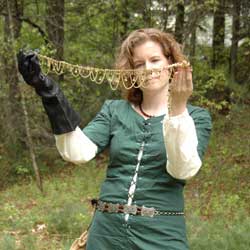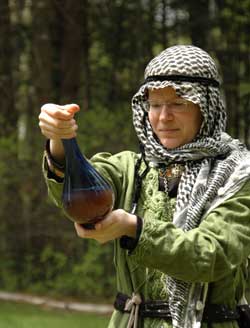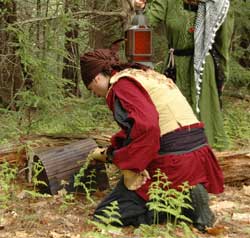Using Items

Magic Items
Every magic item (including a potion) will have a piece of paper attached to it. This is called a "state-of-being" scroll. When your character uses the item, you open the scroll, read its effects, and then carry them out. Do not read the scroll aloud, because its effects may be secret.
"Using" an item depends upon what kind of object it is. Things that are worn (rings, jewelry, clothing) are used as soon as they are worn but are not used if they are carried. Things that are consumed (potions, other food) take effect when swallowed. Magic weapons are used as soon as they are wielded. Other items (such as wands) are used only when the object is held in the hand and concentrated upon.
Rechargeable magic items (that is, items whose powers are useful a certain number of times per day) regain their charges at sunrise.
Potions
Administering a Potion
Potions are magic items that are used by consuming their contents. All potions must be consumed by the person they affect. That is, a Shrink potion must be given to the person to be shrunk, not to the person who wishes to see them shrunk.
Naturally, potions work regardless of the willingness or the awareness of the subject. However, potions will not work if they are mixed with another liquid.
Potions can be administered to a corpse provided it still has a mouth, throat, and stomach.
Each potion will have a difficulty number written on the outside of the potion or state-of-being scroll. Persons with a level of Alchemy equal to or greater than that number may open the scroll and read it without consuming the potion, thus using their skill with alchemy to determine the potion's effects. A potion without a number is presumed to be Alchemy 1 and may be identified by any alchemist.

Potion Types
Spells have both a caster and a target, but potions have only a target (the person who drank the potion).
First Sighted
First Sighted potions are for spells where the "caster" interacts with the target. After consuming the potion, the first person who the character sees is considered the "caster" of the spell.
Body
Body potions are for spells cast on a spirit or a body. Body potions may only be used successfully when both the body and the spirit are present. (The body must be fed the potion.)
Programmed
Programmed potions are for spells that require additional instructions to complete the spell casting. These instructions must be written into the potion's state-of-being scroll at the time of creation. (For instance, the instructions on a Suggestion potion would have to detail what the suggestion is.) These instructions may be arbitrarily complex; however, if the instructions do not apply, the potion has no effect.
Example: If a Hallucination potion has the instruction "The 40 soldiers in front of you appear to be trees," the potion will have no effect if there are only 39 soldiers in front of the victim.
Self
Self potions treat the consumer of the potion as both the caster and the target of the spell. For example, if you consume a Determine Enchantment potion, the nature of any enchantments you are under is revealed to you.

Treasure Chests
Treasure chests are boxes with cards on them stating that they are locked. The only acceptable way of opening these boxes is to have someone with a sufficient level of the Locks skill open the lock, and then open the chest. Do not break these boxes open, unscrew their hinges, or in any other way pry the box open.
Traps
Traps are small boxes with a switch and a trigger of some sort (usually a small piece of fishing line extending from one side). When the switch is flipped to "on," triggering the trap will cause it to emit a buzzing sound, which indicates that the trap has been activated.
When you hear a buzzing sound, figure out who has stepped on the line or otherwise set it off. That person then follows the sound to its source, switches off the trap, and reads the piece of paper attached to the box. That piece of paper describes the effect of setting off the trap.
Protection (armor and magical protection) reduces the damage from traps as if in combat. For example, a three-limb trap against someone wearing two-hit plate mail would result in the wounding of only one limb.
When you activate a trap, leave it where you found it, unless you have the Traps skill. (Only people with Traps may re-use a trap.)
